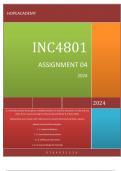Exam (elaborations)
INC4801 ASSIGNMENT 04 – 2024 DUE 11 OCTOBER 2024 1.1 Critically analyse the progress of implementation of inclusive education in India and any other three countries using the themes below (Winter & O’Raw 2010). Substantiate your answer with references t
- Course
- Institution
INC4801 ASSIGNMENT 04 – 2024 DUE 11 OCTOBER 2024 1.1 Critically analyse the progress of implementation of inclusive education in India and any other three countries using the themes below (Winter & O’Raw 2010). Substantiate your answer with references to relevant documents (articles, repo...
[Show more]



